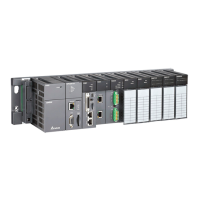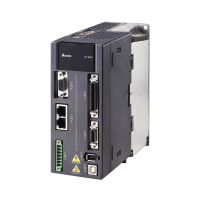AH500 Programming Manual
6-450
b15
b0
b7 b8
39(
9)16#
16#20( ) 16#20( )
16#33(3)
16#20( )
(D1, D0)
3968370
16#20( )
D20
D21
D22
(Regarded as +0003968370)
16#38(8) 16#36(6)
16#30(0)
16#33(3)
16#37(7)
D23
D24
D25
Example 3:
Suppose S is the string “1”. The first character is “ ”. Since the number of characters contained in the
string is less than 6, the string is regarded as “10000”. When the PLC runs, the value in D10 is
10000.
Example 4:
Suppose S is the string “-00001”. The first character is “ ”. Since the number of characters contained
in the string is less than 11, the string is regarded as “-0000100000”. When the PLC runs, the value
in (D11, D10) is -100000.
Additional remark:
1. If the sign character in S is not 16#20, 16#30, 16#2B, or 16#2D, the operation error occurs, the
instruction is executed, SM0 is ON, and the error code in SR0 is 16#2003.
2. If the ASCII code in S is not 16#20, 16#0, or within the range between 16#30 and 16#39, the
instruction is not executed, SM0 is ON, and the error code in SR0 is 16#2003.
3. If the value in S exceeds the device range, the operation error occurs, the instruction is not
executed, SM0 is ON, and the error code in SR0 is 16#2003.
4. If S+2 used in the 16-bit instruction exceeds the device range, SM0 is ON, and the error code
in SR0 is 16#2003.
5. If S+5 used in the 32-bit instruction exceeds the device range, SM0 is ON, and the error code
in SR0 is 16#2003.
6. If the operand S used during the execution of the 16-bit instruction is declared in ISPSoft, the
data type will be ARRAY [3] of WORD/INT.
7. If the operand S used during the execution of the 32-bit instruction is declared in ISPSoft, the
data type will be ARRAY [6] of WORD/INT.

